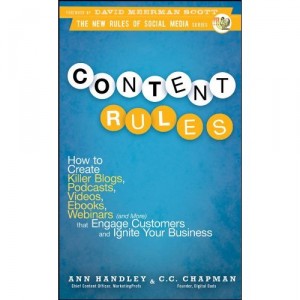 WRITERS. As a trained journalist who currently provides freelance content-marketing support, I was pleased to see that “Training as a print or broadcast journalist” topped the list of the 11 key traits Ann Handley listed in her Marketing Profs article on “How to Hire a Chief Content Officer.” She notes that journalists are trained to tell a story, and their innate understanding of audiences gives them a more nuanced, outside perspective that marketers can sometimes lack.
WRITERS. As a trained journalist who currently provides freelance content-marketing support, I was pleased to see that “Training as a print or broadcast journalist” topped the list of the 11 key traits Ann Handley listed in her Marketing Profs article on “How to Hire a Chief Content Officer.” She notes that journalists are trained to tell a story, and their innate understanding of audiences gives them a more nuanced, outside perspective that marketers can sometimes lack.
Ann, who is chief content officer of Marketing Profs and co-author of the book “Content Rules,” says that finding a Chief Content Officer with the right combination of skills is important because “The person in charge of your content sets the tone for your site.”
If you think you might be interested in becoming a chief content officer, here are the 11 key traits Ann listed and described in her article:
1. Training as print or broadcast journalist
2. Nose for a story
3. Digital intuition (an understanding of how the Web works)
4. Business acumen
5. An amateur passion (e.g. you already produce content just for fun)
6. A community leader (connections with potential contributors)
7. Social DNA
8. An open mind
9. Knowledge of the industry (or not)
10. A winning personality
11. Editorial skills
Ann advises employers that “The key is to find people who understand and embrace the fundamental thesis of Content as Opportunity. Businesses now have both an imperative and the incentive to produce top-shelf content.”
A Wish List, Not a Checklist
In my opinion, the 11 traits Ann Handley describes in her article are right on the money. But these traits probably represent more of a wish list than a checklist. Realistically, it may be very difficult to find a single individual who excels in all 11 areas.
Ann acknowledges that some journalists aren’t interested in content-development work because they fear “selling out” or crossing over to the “dark side” (even if they might earn more money).
Frankly, I think there valid reasons why some journalists don’t regard content development as a viable choice, and I’ll explain why in a minute.
I have worked in a variety of settings: academia, non-profits, a NASA research center, an ad agency, an association, a publishing company, and privately held companies.
In terms of “content development,” working for a NASA Public Affairs Office was ideal. My mission was to find and write stories that would help assure taxpayers and Congressional budget-committee members that government funds were being used productively by the research center’s rocket scientists, aircraft-engine developers, and energy-technology engineers. I particularly loved writing stories about entrepreneurs who were using NASA technology to develop new products or start new businesses. (In fact, a NASA researcher first told me about an advanced networked-communications research project that has since evolved into the Internet.)
But truthfully, my most enjoyable jobs were at the ad agency and publishing company. That’s because in these jobs 1) I was working side-by-side with like-minded writers and creative pros; and 2) writing was part of the core business. The quality of the writing was part of what the publishing firm and ad agency were selling. Content development was never viewed as a questionable overhead expense that might easily get slashed whenever marketing gurus starting promoting the next big thing in marketing.
Why Journalists Might Not Jump at Content Jobs
In addition to feeling undervalued in a marketing-driven work culture, I can think of three other reasons journalists might shy away from seeking full-time content-development jobs:
Fear of repetitive work. In some companies, content development might simply involve writing and editing variations of the same story day after day. Journalists thrive on seeking stories that are fresh, unusual, or important.
Clashing motivations. Most writers don’t go into journalism for the money. In contrast to marketers who seek to make a difference on the company’s bottom line, journalists want to make a difference to our democracy, society, and understanding of a changing world. Working in a newsroom is comfortable because a journalist’s co-workers tend to share the same values and sense of purpose.
Bad experiences with marketers. In the pressroom at trade shows, journalists routinely share horror stories about less-than-positive experiences with marketers and PR representatives. While journalists were striving to earn credibility and the trust of their readers, some marketers have arrogantly tried to dictate how certain stories should be told. Threats to pull advertising from the journalist’s publication always made matters worse.
So, here’s my advice to journalists who might be considering a full-time career as a content developer:
Be selective about the opportunity. It won’t feel like you’re selling out if you genuinely believe in the company’s products, services, and core values. Plus, the company can’t benefit from your skills unless you are genuinely enthusiastic. Authenticity matters.
Understand how your content-development work will be reviewed, evaluated and measured. This will reveal a lot about the culture in which you will work.
Find out how your potential employer defines “quality content.” Ask for examples of the type of work they admire. This can tell you whether you would be a good fit for their organization and whether they are likely to be receptive to your ideas and recommendations.
So, yes, I agree with Ann Handley that corporate content-development positions can provide some terrific opportunities for trained journalists. And, I agree that the employer won’t get the full benefits of having a chief content officer unless they hire a person with the right traits and attitude.
In certain circumstances, an experienced journalist would make an excellent chief content officer. But it’s also important to understand why some journalists may choose not to embrace the thesis of Content as Opportunity.
In my opinion, it can be beneficial to hire journalists to consult with and train marketing staff and then balance content-development projects with other types of work. Some marketing departments get so wrapped up in meeting month-to-month goals they lose sight of other trends occurring in the world around them. So, a good journalist could not only develop content, but also report on emerging trends that might require a company to adjust future goals. Journalists are not only good at content development; some also excel at market research and analysis.
So, what do you think? Agree? Disagree? If you are a journalist who has had experience working on both sides of the fence, I would love to hear from you!
LINKS
Marketing Profs Article:
How to Hire a Chief Content Officer: 11 Key Traits by Ann Handley
Content Marketing Institute:
Chief Content Officer Job Description Sample Template: by Joe Pulizzi
RELATED POSTS
Editorial Excellence Can Help Marketers Escape Content Chaos


